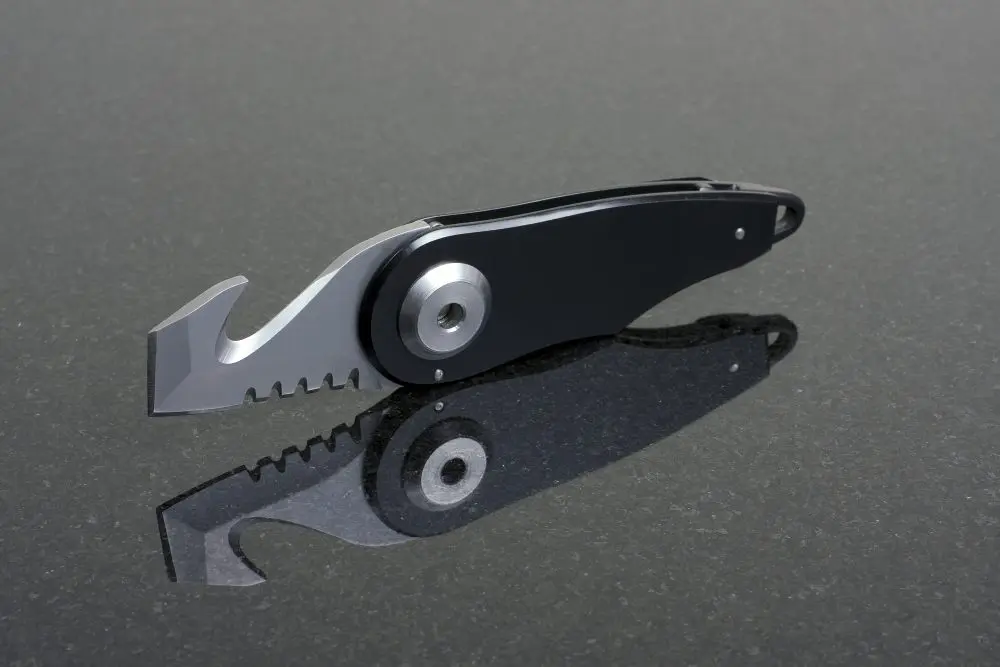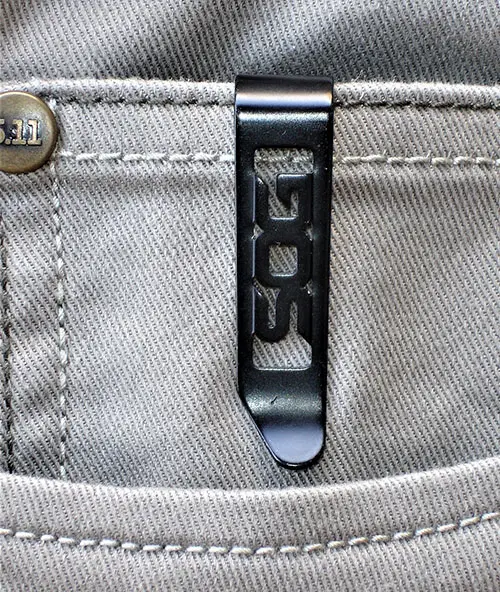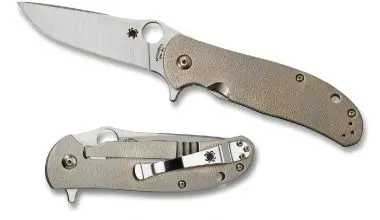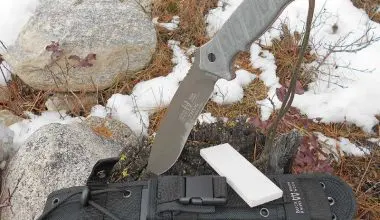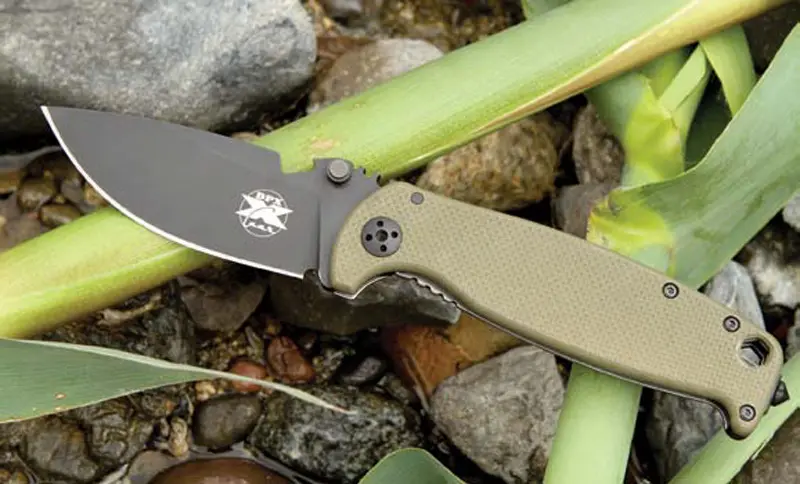
Robert wears many hats, including author, journalist, documentary filmmaker, and host of TV show The World’s Most Dangerous Places. Robert has built a unique career around his experiential style of reporting and documentary filmmaking. He has been referred to as a “SoJo” (solo journalist). While spending time with many different terrorist, rebel and insurgent groups around the world, Robert was able to gather exclusive and unique footage, putting him in a class all his own.
Pelton also has a gear company, DPx Gear Inc. One of its latest offerings is the DPx HEST (Hostile Environment Survival Tool) Folder, which is designed for hard use in the most hostile conditions. About a year and a half ago, I reviewed the original fixed-blade DPx HEST and found it to be an excellent hard-use knife loaded with features, not gimmicks.
The DPx HEST Folder was designed in America but made in Maniago, northern Italy by Lion Steel Knives, which was founded by the Pauletta family in the 1960s. Lion Steel manufactures hunting and classic knives, as well as offering some beautiful custom pieces.
Reading the specs on the DPx HEST Folder has a dizzying effect on the brain, so I’ve decided to simplify them and then elaborate on a few key features.
- 7 5/8-inch long by 1-inch wide blade
- 7.63-inch overall open length
- 4.38-inch closed length
- .187-inch thick blade
- 1/4-inch hex drive, bottle opener, wire stripper
- Solid titanium 6AI4v GR.5 alloy frame
- Patented RotoBlock, frame lock, G10 scale
- Tempered stainless steel glass breaker
- 0.541-inch handle thickness
The rapid deployment system is a practical way to open a knife quickly, making it readily available for use in an emergency. The way it works is quite simple. When the knife is clipped to a pants pocket, the blade is positioned in the tip-up position. As the user pulls the knife out of the pocket, the notch catches on the corner of the pants pocket and deploys the blade as it is pulled out. This is a variation of the classic Emerson Wave feature.
Making smart use of space, the notch on the top of the blade is also a bottle opener. In theory, the wire stripper, in conjunction with the thumb jimping, can be used as a lashing point, but it’s better to use the knife to make other tools like spears rather than risk losing your main survival tool.
Besides, even if you are lucky enough to spear an animal, there is always the risk of it surviving and running off with your knife still in it. Green G10 scales provide the perfect blend of grip, and there is a lanyard attachment that doubles as a ¼-inch Hex driver—yet another example of practical use of space.
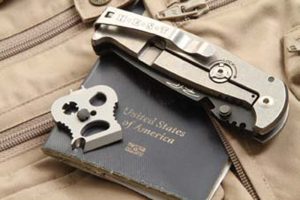
REAL-WORLD USE
I recently went to Alabama to attend the Woodland Survival Course run by Randall’s Adventure Training, the ideal venue to test anything marketed as a survival tool. Knives were the centerpiece of the class.
Almost all aspects of survival came back to the knife. It was used on everything that needed cutting and a few things that didn’t.
Three class participants carried the DPx HEST Folder, each brand new and not really used. The students let me try them out.
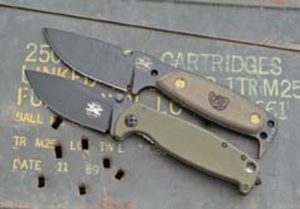
During the small fixed-blade instruction portion of the class, the students took down small saplings, about wrist thickness, with a beater stick (baton). I have never successfully batoned wood with a folding knife. In my book, it’s just not made for that. But I still had to satisfy my own curiosity and try a little whacking on the spine to see what would happen if I needed to split some wood to get to the dry inside. Supposedly, when the RotoBlock lock system on the DPx HEST Folder is engaged, it has the strength of a fixed blade—or so I’d heard.
After one good whack, the knife folded. I checked to make sure the lock was engaged and tried again. And once again, it buckled. There was some noticeable damage to the titanium liner and the marriage between the D2 steel and the titanium liner. A little blade play was also introduced, even when I tightened the blade with the included “skull” tool—it never got rid of the up and down blade play at the pivot point.
As for the cutting performance of the blade, it was perfectly fine. I have always liked the shape of the fixed-blade HEST and was happy to see it duplicated in the folder. The knife peeled bark off river cane and whittled both green and dry wood with no problems. Deep precise cuts to finely detailed woodwork were achievable due to the thin, incredibly sharp edge and even grinds. Edgeholding capability of the D2 steel was excellent.
After a week of outdoor use on a wide array of materials and repeated stabs into the dirt (for photos), the edge still shaved hair off my arm.
While hiking around wearing the DPx HEST Folder, I noticed the pocket clip doesn’t exactly hug the inside of a pants pocket, but then again, my hiking pants are on the thin side. I was hoping the deep carry would make up for it. When I tried it on regular denim blue jeans, it hugged a little bit more.
MR. DP MULTI-TOOL
Included with the DPx HEST Folder is a skull-shaped tool. It serves a few very useful functions like rope and box cutter. It’s a tool for removing the glass breaker and replacing it with a flat screw. The top two horn-like prongs are for tightening the blade at the pivot point. The bottom portion can be used as a small chisel/ prybar, scraper or flat screwdriver.
The DPx HEST Folder is a very capable medium-sized folder. Its outdoor and everyday uses are abundant. As long as there is no batoning done, the DPx HEST Folder is a useful tool when paired with a larger fixed blade or hatchet to take on the most hostile environments or your nearest campsite. The suggested retail price of the DPx HEST Folder is $249.00.
